
A clutch is a mechanical device that allows the output shaft to be disconnected from the rotating input shaft. The clutch's input shaft is typically attached to a motor, while the clutch's output shaft is connected to the mechanism that does the work.

Clockwork refers to the inner workings of either mechanical devices called clocks and watches or other mechanisms that work similarly, using a series of gears driven by a spring or weight.
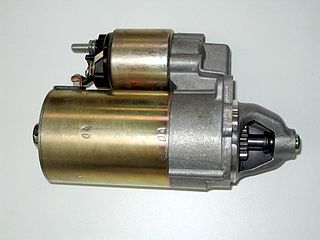
A starter is a device used to rotate (crank) an internal-combustion engine so as to initiate the engine's operation under its own power. Starters can be electric, pneumatic, or hydraulic. The starter can also be another internal-combustion engine in the case, for instance, of very large engines, or diesel engines in agricultural or excavation applications.
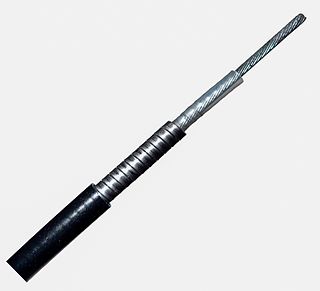
A Bowden cable is a type of flexible cable used to transmit mechanical force or energy by the movement of an inner cable relative to a hollow outer cable housing. The housing is generally of composite construction, consisting of an inner lining, a longitudinally incompressible layer such as a helical winding or a sheath of steel wire, and a protective outer covering.
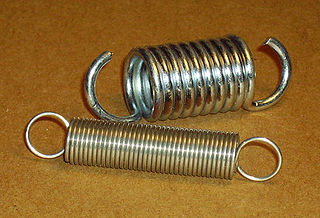
A spring is a device consisting of an elastic but largely rigid material bent or molded into a form that can return into shape after being compressed or extended. Springs can store energy when compressed. In everyday use, the term most often refers to coil springs, but there are many different spring designs. Modern springs are typically manufactured from spring steel. An example of a non-metallic spring is the bow, made traditionally of flexible yew wood, which when drawn stores energy to propel an arrow.

In mechanical or automotive engineering, a freewheel or overrunning clutch is a device in a transmission that disengages the driveshaft from the driven shaft when the driven shaft rotates faster than the driveshaft. An overdrive is sometimes mistakenly called a freewheel, but is otherwise unrelated.

A DC motor is an electrical motor that uses direct current (DC) to produce mechanical force. The most common types rely on magnetic forces produced by currents in the coils. Nearly all types of DC motors have some internal mechanism, either electromechanical or electronic, to periodically change the direction of current in part of the motor.

In horology, a movement, also known as a caliber or calibre, is the mechanism of a watch or timepiece, as opposed to the case, which encloses and protects the movement, and the face, which displays the time. The term originated with mechanical timepieces, whose clockwork movements are made of many moving parts. The movement of a digital watch is more commonly known as a module.
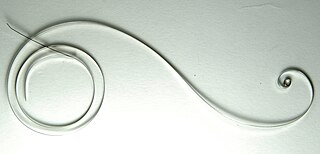
A mainspring is a spiral torsion spring of metal ribbon—commonly spring steel—used as a power source in mechanical watches, some clocks, and other clockwork mechanisms. Winding the timepiece, by turning a knob or key, stores energy in the mainspring by twisting the spiral tighter. The force of the mainspring then turns the clock's wheels as it unwinds, until the next winding is needed. The adjectives wind-up and spring-powered refer to mechanisms powered by mainsprings, which also include kitchen timers, metronomes, music boxes, wind-up toys and clockwork radios.

A mechanically powered flashlight is a flashlight that is powered by electricity generated by the muscle power of the user, so it does not need replacement of batteries, or recharging from an electrical source. There are several types which use different operating mechanisms. They use different motions to generate the required power; such as squeezing a handle, winding a crank, or shaking the flashlight itself. These flashlights can also be distinguished by the technique used to store the energy: a spring, a flywheel, a battery or a capacitor.

A preselector gearbox is a type of manual transmission mostly used on passenger cars and racing cars in the 1930s, in buses from 1940-1960 and in armoured vehicles from the 1930s to the 1970s. The defining characteristic of a preselector gearbox is that the gear shift lever allowed the driver to "pre-select" the next gear, usually with the transmission remaining in the current gear until the driver pressed the "gear change pedal" at the desired time.
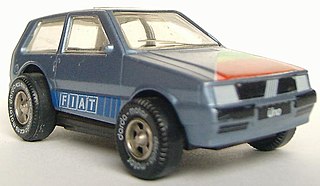
Darda is the name of a German toy car racing set which was most popular in Europe and the USA throughout the 1980s and '90s.

An automatic watch, also known as a self-winding watch or simply an automatic, is a mechanical watch where the natural motion of the wearer provides energy to wind the mainspring, making manual winding unnecessary if worn enough. It is distinguished from a manual watch in that a manual watch must have its mainspring wound by hand at regular intervals.

Choro-Q is a line of Japanese 3–4 cm pullback car toys produced by Takara. Known in North America as Penny Racers, they were introduced in late 1978 and have seen multiple revisions and successors since. Choro-Qs are stylized after real-world automobiles, with real rubber wheels and a pullback motor that makes them move. Each car has a coin slot at the back, where inserting a penny will make it perform a wheelie when the car is released.

A mechanical watch is a watch that uses a clockwork mechanism to measure the passage of time, as opposed to quartz watches which function using the vibration modes of a piezoelectric quartz tuning fork, or radio watches, which are quartz watches synchronized to an atomic clock via radio waves. A mechanical watch is driven by a mainspring which must be wound either periodically by hand or via a self-winding mechanism. Its force is transmitted through a series of gears to power the balance wheel, a weighted wheel which oscillates back and forth at a constant rate. A device called an escapement releases the watch's wheels to move forward a small amount with each swing of the balance wheel, moving the watch's hands forward at a constant rate. The escapement is what makes the 'ticking' sound which is heard in an operating mechanical watch. Mechanical watches evolved in Europe in the 17th century from spring powered clocks, which appeared in the 15th century.
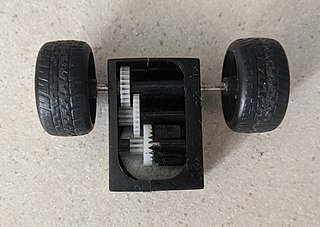
A friction motor is a simple mechanism to propel toy cars, trucks, trains, action figures and similar toys. The motor consists of a large flywheel which is connected to the drive wheels of the toy via a very low gear ratio, so that the flywheel revolves faster. The flywheel's axis is perpendicular to the direction in which the toy faces and moves. When the toy is pushed forward, the drive wheels engage the flywheel. Pushing the vehicle forward repeatedly spins this flywheel up to speed. When let go, the flywheel drives the vehicle forward. The flywheel stores the kinetic energy of the initial acceleration and propels the toy after it is released, by forcing the perpetual motor that revolves the kinetic energy.

A wind-up toy is an automaton toy powered by a clockwork motor.
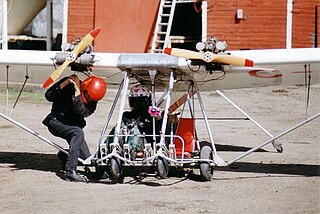
Rope start is a method of starting an internal combustion engine, usually on small machines, such as lawn mowers, chainsaws, grass trimmers, ultralight aircraft, small outboard motors and portable engine-generators. Also used on some small vehicles such as small go-karts, minibikes, and small ATVs.
In horology, a wheel train is the gear train of a mechanical watch or clock. Although the term is used for other types of gear trains, the long history of mechanical timepieces has created a traditional terminology for their gear trains which is not used in other applications of gears.
Pull back or pullback may refer to:


















